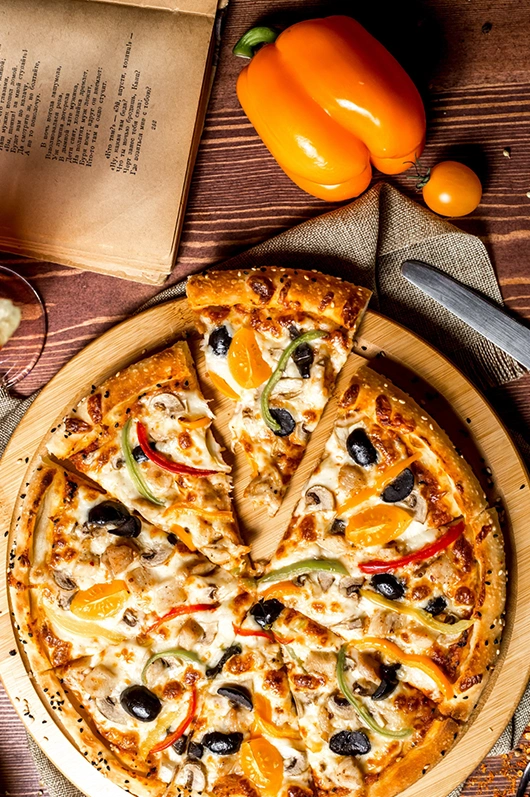

Top Health Benefits of Chicken Pizza You Need to Know
This homemade chicken pizza is packed with a variety of nutrients that make it a balanced meal. The whole wheat or regular pizza crust provides carbohydrates that offer energy, while the chicken adds a healthy dose of lean protein, essential for muscle repair and growth. The addition of vegetables like bell peppers, mushrooms, and olives not only enhances the flavor but also boosts the fiber and vitamin content of the pizza, promoting digestive health and overall well-being. The cheese provides calcium and other essential nutrients for bone health. However, if you choose to use a low-fat cheese, it can help reduce the overall fat content while still delivering the creamy texture and taste you love. The toppings, such as tomatoes and herbs, offer antioxidants that support immune function, making this pizza not only a delicious treat but also a nutritious option.
 Wheat Flour : 300 g
Wheat Flour : 300 g Water : 150 Mili Liter
Water : 150 Mili Liter Yeast : 1 Teaspoon
Yeast : 1 Teaspoon Sugar : 1 Teaspoon
Sugar : 1 Teaspoon Salt : 1/2 Teaspoon
Salt : 1/2 Teaspoon Olive Oil : 2 Tablespoon
Olive Oil : 2 Tablespoon Cooking Oil : 1 Tablespoon
Cooking Oil : 1 Tablespoon Chicken Breast : 2 Piece
Chicken Breast : 2 Piece Mushroom : 150 g
Mushroom : 150 g Olive : 8 Piece
Olive : 8 Piece Bell Pepper : 1 Piece
Bell Pepper : 1 Piece Orange : 1 Piece
Orange : 1 Piece Mozzarella : 200 g
Mozzarella : 200 g Tomato Sauce : 4 Tablespoon
Tomato Sauce : 4 Tablespoon Salt : as needed
Salt : as needed black pepper : to taste
black pepper : to taste Thyme : to taste
Thyme : to taste Garlic Powder : to taste
Garlic Powder : to tasteRecipe :
For 2 Pizza
Enjoy your delicious homemade pizza!
When preparing this pizza, there are a few key steps to ensure the best results. First, it's essential to make sure the dough has enough time to rise. Allowing it to rest for about an hour helps the yeast activate properly and ensures a light, fluffy crust. While rolling out the dough, try not to overwork it, as this can make the crust tough. Be sure to evenly spread the pizza sauce and toppings to avoid sogginess; using a thin layer of sauce will prevent the dough from becoming too moist. When assembling the toppings, consider the cooking time of each ingredient. For example, thinly sliced vegetables like mushrooms and bell peppers cook more quickly, so they should be placed on top of the chicken to avoid overcooking. Lastly, preheat your oven to the proper temperature (around 200°C or 400°F) before placing the pizza inside. This will help achieve a perfectly crispy crust and evenly melted cheese. Don't forget to check the pizza towards the end of cooking to avoid burning the edges.

This pizza may not be suitable for certain dietary preferences or restrictions. For individuals following a ketogenic diet, the traditional pizza crust is high in carbohydrates, making it incompatible with the low-carb, high-fat nature of the diet. Additionally, those adhering to a gluten-free diet should replace the regular pizza crust with a gluten-free alternative to avoid discomfort or allergic reactions. Vegan individuals may want to replace the chicken and cheese with plant-based alternatives, while vegetarians can easily omit the chicken and add more vegetables or plant-based proteins. Those on a low-calorie diet should be cautious with portion sizes and consider using less cheese or opting for a thin crust. For people following a high-protein diet, this pizza is a good option, especially if you increase the chicken portion or add other protein-rich toppings. While the pizza provides some health benefits, it may not align with strict paleo or Mediterranean diets due to the inclusion of cheese and refined flour. However, with slight modifications, this dish can be adapted to suit many different dietary needs.
...